122 - Embryology of the Esophagus
Editors: Shields, Thomas W.; LoCicero, Joseph; Ponn, Ronald B.; Rusch, Valerie W.
Title: General Thoracic Surgery, 6th Edition
Copyright 2005 Lippincott Williams & Wilkins
> Table of Contents > Volume II > The Esophagus > Section XXIII - Benign Esophageal Disease > Chapter 142 - Chagas' Disease of the Esophagus
Chapter 142
Chagas' Disease of the Esophagus
Manoel Ximenes III
ETIOLOGY
American trypanosomiasis is an endemic disease caused by a protozoan, Trypanosoma cruzi, discovered by the Brazilian scientist Carlos Chagas (1909). Soon after the discovery, Chagas postulated a link between esophageal symptoms and the parasite when he observed the frequency of the infection and the dysphagia in rural areas of Brazil where the disease is endemic. Etzel (1934), Correa Neto (1935), and Ramos (1935) studied the association between the digestive tract mega- syndromes and involvement of the heart and other organs. The organism is transmitted to humans and other mammals through insects of the species Triatoma when they bite skin to suck blood. Transmission may also occur by transfusion of contaminated blood, congenitally, and during organ transplantation.
Trypanosomiasis has a distribution throughout the Americas, from latitude 42 degrees north (northern California) to latitude 45 degrees south (southern Argentina and Chile), but the human infection extends from the southern United States to the state of Chubut in Argentina. Only three authenticated cases have been described in the United States, but the large number of Latin American immigrants who may be contaminated with T. cruzi may become a source of contamination through blood transfusion or organ donation.
Ninety million people from a total population of 360 million in Latin America (25%) are at risk of contracting the disease. Only one-third of those infected may show signs of the disease (i.e., 4.8 to 5.4 million people), and of these, 10% to 12% have overt esophageal achalasia.
Triatomines of the order Hemiptera, family Reduviidae, and subfamily Triatominae that transmit this malady consist of more than 100 species; another 100 vertebrate hosts have been naturally infected with the parasite. Triatomines usually live in rural areas in easy contact with vertebrates (e.g., birds, reptiles, bats, and dogs), but in recent years, new epidemiologic conditions include a peridomestic environment and inside houses. Of all potential vectors of T. cruzi, five are of special importance, notably in South America: Triatoma infestans, T. brasiliensis, T. dimidiata, T. sordida, and Panstrongylus megistus. Rhodnius prolixus and R. pallescens are active in Central America and Panama.
In the United States, 10 species of Triatominae have been described, including T. sanguisuga in Illinois, T. protacta in the Midwest, and T. rubida uhleri and T. gerstaeckeri in Texas, Arizona, and New Mexico. These insects are not important in transmission in North America, however, because they do not defecate right after a blood meal and they live away from the domestic environment. Figure 142-1 demonstrates the distribution of Triatominae on the continent.
PATHOPHYSIOLOGY
Once the parasite penetrates the skin, a local skin reaction occurs and leads to a septicemic stage. The chronic phase follows, with manifestations of the disease in several target organs, including the heart, digestive tract, and nervous system.
Since the early studies by Hurst and Rake (1930), it has been demonstrated that the most important changes in Chagas' disease are related to the autonomic nervous system, especially the Auerbach plexus. Koberle and Nabor (1955) and Koberle and Alcantara (1989), after painstaking studies, demonstrated that the loss of ganglion cells during the acute phase involves a neurotoxin. This theory has not been widely accepted, however, and now mechanisms linked to cell immunity are strongly favored. T. cruzi organisms may be directly responsible for the reduction and subsequent destruction of the autonomic nervous system and consequently for the pathologic alterations in the affected organs. Another described mechanism is related to the antigenicity of the parasite triggering an autoimmune response. Another possibility related to the immune mechanism is that the parasite antigens bind to host cells and these cells become targets of the host immune system. An allergic reaction might also be involved in the pathogenesis of the tissue lesions, based on the findings that no relation exists between the localization
P.2162
of the tissue lesions and the concentration of parasites and that the mononuclear infiltrate does not necessarily correspond to sites where the parasites are present.
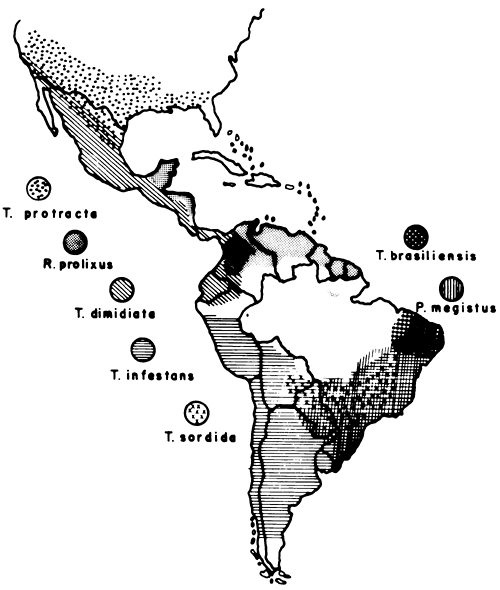 |
Fig. 142-1. Geographic distribution of the main Triatominae vectors of Trypanosoma cruzi. Courtesy of Z. Brener and Z. A. Andrade. |
According to Andrade and Andrade (1989), infection by T.cruzi may assume different patterns in the several geographic areas in which the disease is seen. The variety results from different strains of parasites that may grow quickly (type I), intermediately (type II), and slowly (type III). Different strains of T.cruzi have been isolated by means of isoenzymes, schizodemes, and DNA probes. By gel electrophoresis, they were classified into groups with identical isoenzyme profiles. The World Health Organization (1991) has identified three types. Zymodemes 1 and 3 were identified in reservoirs and vectors of the nondomestic cycle; zymodeme 2 was isolated in infected patients with chronic Chagas' disease. The different strains may explain why the same disease has clinical findings that differ according to geography. For instance, in the central plateau of Brazil, the mega- syndromes are prevalent, whereas in Venezuela, the disease shows a preference for the heart; in the United States, it is almost nonexistent.
According to Koberle and Alcantara (1989), the number of ganglions in the myenteric plexus in the normal esophagus varies between 220,000 and 250,000. Striated muscles are prevalent in the upper part of the esophagus, whereas smooth muscle predominates in the lower one-third. Ganglion cells are absent in the upper part and are found in numbers in the distal esophagus, thus explaining why dilatation occurs from the midesophagus down when ganglion cells are destroyed. When the proportion of parasympathetic ganglion cells lost reaches 90%, symptoms related to absence of peristalsis, loss of coordination, and achalasia with distention, hypertrophy, and hyperplasia of the muscle fibers appear. The thresholds for the development of symptoms of the other organs are 20% destruction of ganglion cells in the heart, 60% in the sigmoid esophagus, and near 80% in the bronchi.
No difference is noted in the number of lost ganglion cells in either the idiopathic achalasia found in Europe or North America or the megaesophagus related to Chagas' disease. Differences between Chagas' megaesophagus and idiopathic achalasia are related to the fact that the former always appears in the endemic areas of Latin America and is associated with other affected organs (heart, digestive system), and that serologic tests are positive for Chagas' disease more than 90% of the time. The end results being the same, identical surgical treatment can be applied to both conditions.
CLINICAL FEATURES
Chagas' disease, when it affects the esophagus, usually is seen 7 to 10 years after the primary infection. According to Rezende (1988), the disease is seen in patients between 20 and 40 years of age, with a prevalence in men (65%) from an endemic area. With the current trend of migration into the cities, many of these patients are seen in major urban centers.
Once infected, three stages of the disease may be elicited: acute, intermediate asymptomatic, and symptomatic. The incubation period usually lasts 1 week, and two signs may be seen: chagoma (hardening of the skin with plates of red color) at the skin site where the bug has bitten, and Roma a's sign if the infection takes place in the orbital area. Only 1% to 2% of infected persons show signs of the infection; the remainder are asymptomatic. The mortality rate at this stage is approximately 2% to 3%. Only 30% of those infected demonstrate overt signs and symptoms of the protracted disease that affect the heart (50%), esophagus, and colon (12%). Any other organ or system may be affected, but to a lesser extent.
In the initial stage, diagnosis is made by direct examination of a thin blood sample and identification of the parasites. Cure can be obtained at this stage with the use of drugs. In the chronic stage, no medication is helpful.
Symptomatic Esophageal Involvement
The main symptoms include dysphagia, pain, regurgitation, singultus, salivation with hypertrophy of the salivary gland, cough, constipation, and weight loss. The difficulty
P.2163
in swallowing is seen in most patients with Chagas' megaesophagus, and it may occur suddenly or slowly. The latter circumstance is most common and frequently follows a hurried meal containing solid food or occurs after an emotional bout. Cold food is not well tolerated. Patients learn several maneuvers to get food down into the stomach, such as arching backward, swallowing air, drinking large amounts of liquids, or taking deep breaths. As the dysphagia worsens, these patients are no longer able to eat a decent meal among unaffected people.
The pain has two manifestations. Odynophagia is seen at the time of swallowing and almost always means a hyperactive esophagus in the early stages of the disease. Pain radiates to the jaws, shoulder, and arm, lasting from a few minutes to hours. It is not related to reflux and is relieved with the use of sublingual nitrates or after surgical treatment. The second type of pain or discomfort is described as retrosternal or substernal. Substernal pain may be elicited after eating a solid meal rapidly, and is relieved by self-induced regurgitation. This maneuver is soon learned and is frequently used to relieve the symptoms. Food impaction causes constant pain, requiring endoscopic removal.
Regurgitation is a frequent symptom, with the contents depending on the stage of the disease. In the early phase, the material regurgitated is clear and contains saliva and very little food; regurgitation occurs soon after eating. In the advanced stage, regurgitation is delayed and occurs frequently during the night. The material contains undigested, fermented food. At night, the patient frequently is awakened with cough and suffocation. This symptom occurs in 55% to 90% of cases and should be distinguished from vomiting, which is unusual in megaesophagus.
Singultus (hiccup) may be an early indication of esophageal involvement; it may cause disabling discomfort lasting for days or weeks, requiring urgent treatment. The heartburn sensation frequent in gastroesophageal reflux (GER) is uncommon in megaesophagus. Excessive salivation and hypertrophy of the salivary glands, especially involving the parotid glands, are common findings in Chagas' megaesophagus.
In the more advanced stage, cough is seen in more than 20% of the patients and usually occurs at night because of aspiration of esophageal contents into the pharynx and trachea. Three percent to 5% of patients present with pulmonary complications of an inflammatory nature.
Bowel constipation is attributable to two mechanisms. The first is that food is retained in the esophagus and little feces are formed, and the second is associated megacolon. Constipation occurs in 22% of cases in my and my colleagues' (1987) experience. Under these circumstances, the megaesophagus should be treated first to relieve constipation and dysphagia.
Malnutrition is common and is usually seen in younger patients. Regurgitation is frequent and leads to emaciation and cachexia. In children, lack of normal physical growth and mental retardation are seen. The triple A syndrome (adrenal insufficiency, achalasia of the cardia, and alacrima), is usually seen in childhood and was described by Allgrove and associates in 1978. This is a rare autosomal recessive condition. The AAAS gene product is a protein named ALADIN (alacrima, achalasia, adrenal insufficiency, neurologic disorder), which comprises 546 amino acids and belongs to the WD repeat family. Neuromuscular abnormalities, as noted by Orrell and Clark (2002), may also be associated with this syndrome, with slowly progressive distal muscular atrophy in the legs, dysmorphic facial features, and moderate mental retardation.
DIAGNOSIS
Chagas' megaesophagus is strongly suspected on clinical grounds alone and is diagnosed by radiologic examination, scintigraphy, endoscopy, manometry, and laboratory tests. Plain chest radiographs may demonstrate some features usually seen in Chagas' megaesophagus, such as an air fluid level, tracheal deviation, mediastinal enlargement, lung changes, and absent gastric air bubble (Fig. 142-2).
Radiologic Studies
Before proceeding with contrast-enhanced studies of the esophagus, one should take time to empty the organ with a large-bore tube to facilitate visualization of the changes present. The same should be done before endoscopy and surgery. The patient should be examined in both supine and upright positions to evaluate esophageal motility, stasis, the possible presence of esophageal carcinoma, and opening of the lower esophageal sphincter (LES).
Based on the findings of contrast retention, caliber, contractility, tonicity of lower segment, size, and transverse diameter of the organ, Zucoloto and Rezende (1990) divided the chagasic megaesophagus into three stages. In stage I, the esophagus is not dilated, but the barium meal is partially retained and an air column remains along the length of the organ. The transverse diameter is up to 4 cm, and stasis is noted at 10 seconds. In stage II, mild dilatation and uncoordinated muscular activity are noted in the lower part of the esophagus. The transverse diameter is between 4 and 7 cm, and barium stasis occurs after 5 minutes. In stage III, the esophagus is hypotonic and hypokinetic, with dilatation and stasis after 30 minutes. The transverse diameter is beyond 7 cm, sometimes lying down over the diaphragm (the so-called sigmoid esophagus) (Fig. 142-3). Staging of the disease process is important when it comes to deciding on treatment.
The radiologic examination is performed in the following manner. The patient fasts for 12 hours. After the esophagus
P.2164
is emptied, the barium meal (200 mL of water and 100 g of barium) is delivered, and three exposures are obtained at 180-cm distance within 10 seconds, 5 minutes, and 30 minutes after the barium swallow.
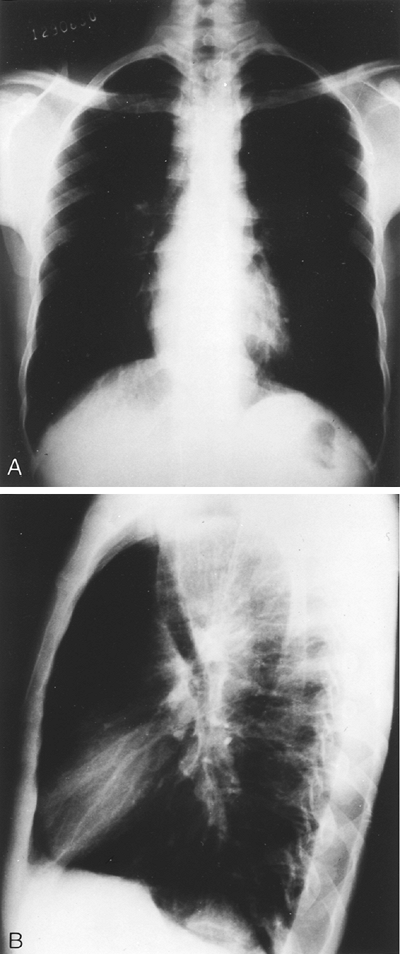 |
Fig. 142-2. A. Posteroanterior radiograph of the chest reveals widening of the mediastinum, shadowing to the right of the superior vena cava, and absent gastric air bubble. B. Lateral view shows anterior displacement of the trachea and air fluid level in the esophagus. |
Scintigraphy
Radioisotope scanning has been used extensively to verify esophageal transit time and dysfunction and to assess the therapeutic response to treatment, including the presence of GER disease. The test is performed after swallowing a liquid or solid meal containing technetium 99m (99mTc) sulfur colloid (100 to 300 mL) while in the supine and sitting positions. The counts are made in the area of interest and at fixed intervals (every 0.25 second for 40 seconds), between the upper one-third, middle, and lower one-third of the esophagus and the stomach.
With this technique, Rezende (1985) found a normal esophageal transit time of 8.3 2.2 seconds (mean standard deviation) in the supine position and 6.3 1.1 seconds in the sitting position. When the transit time exceeded 40 seconds, two patterns were observed: partial retention and total retention. Cases in which the shuttling movement of the radioisotope between the distal and proximal esophagus had an uncoordinated transit pattern were classified as adynamic. This method agreed with manometric findings in 88.6% of the cases and had a sensitivity of 86.3% and a specificity of 93.3%. In summary, Rezende (1985) found the following transit patterns: normal; prolonged; partial retention (with and without incoordination); and total retention with incoordination (adynamic). Patients with peristaltic activity in the esophagus had a normal esophageal transit time in the supine position and some retention while in the erect position, regardless of the function of the LES. Those without peristaltic waves had retention in both positions, whether the lower sphincter was functioning or not.
Endoscopy
Endoscopic examination should be performed before any attempt at surgical treatment of megaesophagus. The organ should be thoroughly washed to verify all the possible changes in the esophagus and stomach. The flexible scope is preferable to the rigid device. Rezende and associates (1985) performed 722 endoscopies in 600 cases of megaesophagus in a 7-year period. Of this total, 480 were untreated and 120 had been treated. The findings included the following: esophagitis, 15 cases (2.5%); reflux esophagitis, 41 (6.5%); esophageal stenosis, 8 (1.3%); cancer, 5 (0.8%); hiatal hernia, 3 (0.5%); esophageal varices, 2 (0.3%); and leukoplasia, 1 (0.2%). In the stomach, duodenum-bile
P.2165
reflux was found in 173 patients (30.4%), chronic gastritis in 109 (18.2%), gastric ulcer in 10 (1.8%), gastric polyposis in 2 (0.4%), gastric cancer in 1 (0.2%), megabulb-dilated duodenum in 9 (1.6%), and duodenal ulcer disease in 10 (1.8%). The high incidence of duodenal-bile reflux may be related to the denervation of that portion of the pylorus.
Manometric Studies
The depopulation of the ganglions in the chagasic esophagus leads to lack of peristalsis, achalasia of the LES, elevation of the resting pressure, and increased response to stimulation of the esophageal smooth muscle by cholinergic drugs. Swallowing in the normal person involves peristaltic and uncoordinated contractions with opening of the lower sphincter. In the chagasic individual, normal peristalsis is replaced by synchronous movement in all levels of the organ, and the LES does not open (Fig. 142-4). These alterations are observed in the lower one-third of the esophagus. The upper esophageal sphincter shows no changes, but the lower sphincter demonstrates lack of relaxation in approximately one-half of patients in whom the esophagus is not dilatated. In the more advanced cases with dilatation, the lower sphincter does not relax in more than 80% of patients.
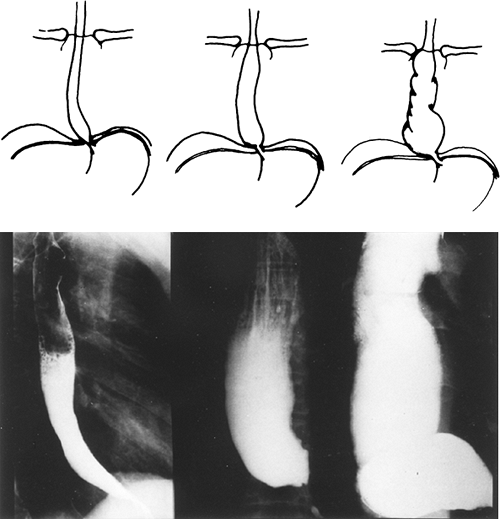 |
Fig. 142-3. Three stages of megaesophagus. Stage I: little dilatation, barium retention, air column, and transverse diameter no more than 4 cm. Stage II: dilatation, uncoordinated muscular activity, and transverse diameter between 4 and 7 cm. Stage III: hypotonic and hypokinetic with dilatation and stasis after 30 minutes, transverse diameter beyond 7 cm. |
Controversy surrounds LES pressure in chagasic individuals compared with those with idiopathic achalasia. According to Dantas and associates (1990), some evidence shows that the denervation affects both inhibitory and cholinergic excitatory neurons. If this is true, it should be anticipated that the resting lower sphincter pressure is low or normal in patients with Chagas' disease compared with the elevated pressure in those with idiopathic achalasia. These differences may be related to the various methods of investigation.
Laboratory Tests
More than 95% of the time, patients with chagasic esophagopathy have tests that are positive and diagnostic of the disease. In the acute phase, the parasite may be seen directly in a blood sample, using thin blood smear, thick blood smear, or examination of fresh blood between slide and coverslip. The various methods available are listed in Table 142-1.
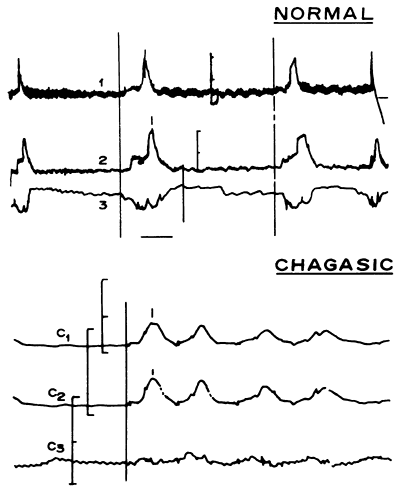 |
Fig. 142-4. Manometric findings in the normal individual (upper tracings) and the chagasic individual (lower). Catheters placed in the esophageal body and at the cardia demonstrate the normal peristaltic waves and opening of the lower esophageal sphincter in the healthy person and the nonperistaltic contractions and lack of relaxation in the chagasic patient. |
P.2166
TREATMENT
In the acute phase of the disease, the medical treatment is curative, whereas in the chronic stage, the therapeutic aims are the correction of the late consequences of the denervation of the various organs affected: esophagus, colon, or heart.
Table 142-1. Diagnostic Methods in Chagas' Disease | |||||||||||||||||||||||||||||||||
|---|---|---|---|---|---|---|---|---|---|---|---|---|---|---|---|---|---|---|---|---|---|---|---|---|---|---|---|---|---|---|---|---|---|
| |||||||||||||||||||||||||||||||||
Medical Therapy
Two drugs currently used in the acute phase are nitrofurantoin (a nitrofuran derivative) and benzimidazole (a mibendazole). The former is given in daily doses of 10 mg/kg to adults and 15 mg/kg to children for 2 to 3 months, and the latter in doses of 5 to 10 mg/kg for the same amount of time. Allopurinol (600 mg/day for 30 to 60 days) is in the experimental stage, but its use seems promising.
In the chronic phase, Annese and associates (1996) reported the use of intersphincteric injection of botulinum toxin in 16 individuals and compared this with a group of patients managed by placebo and pneumatic dilation. The efficacy of treatment was judged by a symptom score, esophageal manometry, and scintigraphy. LES pressure and esophageal retention were reduced by one-half in the groups treated either by pneumatic dilation or botulinum toxin injection, but the follow-up time was only 30 days. Pasricha (1996) and Schiano (1998) and their colleagues, as well as Gordon and Eaker (1997), described the same approach, using 20 units of botulinum toxin in the four quadrants of the LES. The short time of follow-up (6 to 13 months) and the relapse rate (31% to 67%) may predict the shortcomings of this type of treatment. This type of therapy is expensive (around US $300 just for the botulinum toxin), and at 12 months only 32% of patients treated were in a symptomatic remission, as compared with 70% of patients treated by pneumatic dilation. Spechler (1999) suggested that at the present time, botulinum injection therapy may be tried in the elderly population or in patients with serious comorbidity in whom other forms of treatment pose serious risk.
In the chronic symptomatic stage, several therapeutic options are available, regardless of whether one is dealing with idiopathic or chagasic achalasia (Table 142-2).
Surgical Therapy
The surgical treatment of this condition is simple and easily performed by any surgeon. Relief of dysphagia should be good to excellent in over 90% of cases, with minimal morbidity and mortality (<1%).
Bougienage by patient or physician is seldom used. Dilation is practiced in many institutions, but its benefit rarely exceeds that of surgery. In a review by Reynolds and Parkman (1989) of 1,363 dilated patients, excellent to good results were obtained in 69%, 18% required subsequent dilation, and 12% required a subsequent esophagomyotomy. In regard to complications of dilation, Ferguson (1991) found that of 1,049 patients, 1.4% had perforation, 1.2% had aspiration, 22.6% had GER, and 0.3% died.
Anselmino and associates (1997) reported a 14.5% rate of perforation after pneumatic dilation in a group of 55 patients. The same author obtained relief of dysphagia in 77% of the dilated group, whereas 91% relief was seen in the patients with surgical esophagomyotomy.
Table 142-2. Treatment Choices in Chagas' Megaesophagus | |
|---|---|
|
P.2167
The surgical treatment of achalasia of either etiology is based primarily on the procedure described by the German surgeon Heller in 1913. The original two myotomies, anterior and posterior, are no longer practiced today, and surgeons around the world do an anterior incision only, with or without an antireflux procedure. Prospective randomized studies comparing the two methods (dilation versus surgery) are few. Csendes and colleagues (1989) completed such a study of 81 patients with 95% good results for the operated patients and 56% good results in those receiving dilation (Table 142-3). In a prospective randomized study of 40 patients, of whom one-half had dilation and one-half had myotomy, Felix and associates (1998) found equally good functional results, although esophageal pH monitoring indicates that dilation produces a greater index of esophageal acid exposure time.
Table 142-3. Results of Esophagomyotomy versus Dilation | ||||||||||||||||||||||||||||||||||||
|---|---|---|---|---|---|---|---|---|---|---|---|---|---|---|---|---|---|---|---|---|---|---|---|---|---|---|---|---|---|---|---|---|---|---|---|---|
| ||||||||||||||||||||||||||||||||||||
The technique of esophagomyotomy is simple and should adhere to the basics:
Empty the esophagus and stomach completely before the anesthesia.
Remember that there is no need for a long incision in the wall of the esophagus (6 to 8 cm or less is adequate, and into the stomach, stop at the first gastric vessels).
Dissect the hypertrophied muscle approximately 50% of the circumference of the organ.
Do not use a complete wrap around the gastroesophageal junction (360 degrees), especially in the aperistaltic esophagus. Placing a loose, anterior 180-degree wrap anteriorly keeps the esophagus intraabdominal, maintains the edges of the myotomy apart, and seals any perforation.
Repair any hiatal hernia.
A nasogastric tube is not necessary.
A liquid diet is offered the same day of the operation, and hospital discharge is possible in 24 to 48 hours. This technique has been used by the author (1991) and by the author and Gaiotto (1997) in more than 305 cases: 180 through the chest without an antireflux maneuver and 125 through the abdomen with anterior wrap, achieving similar results with both techniques (Fig. 142-5).
The Heller myotomy, when properly performed, should result in greater than 90% success, with mortality below 1% and morbidity near zero, as reported from institutions experienced in dealing with this disease. Table 142-4 shows the results of four major series for the management of Chagas' megaesophagus.
The question of whether to add a fundoplication to the myotomy has been debated for many years. Addressing this point, Andreollo and Earlam (1987) analyzed 5,002 cases in the English literature and found that when the operation was performed through the abdomen rather than through the chest, the incidence of reflux was twice as high (13.2% for laparotomy vs. 7.4% for thoracotomy). The true incidence, however, is difficult to assess because it depends on many variables, such as the length of the incision in both directions, the type of plication (anterior, posterior, loose, tight), the degree of wrap, and the methods used to assess GER. As I and my colleagues (1988) noted, both preoperative and postoperative assessments of the phases of chagasic megaesophagus are standard.
In the advanced stage of the disease, the simpler Heller myotomy is not often successful. In this circumstance, a cardioplasty with an endoluminal valve has been used. The procedure was originally described by Wendel (1910) and later modified by Thal and Hatafuku (1965), as well as by Hatafuku and associates (1972) for peptic stricture of the distal esophagus. The procedure is performed through a midline incision. The left triangular liver ligament is sectioned, followed by full mobilization of the esophagus and preservation of both vagi. A longitudinal full-thickness incision
P.2168
is made through the narrowed segment, 6 to 8 cm in the proximal esophagus and 1 to 2 cm into the stomach. If necessary, a few stitches are placed transversely to widen the posterior gastroesophageal junction. The endoluminal antireflux valve is made with sutures placed between the gastric fundus or anterior gastric wall and the lower opening of the gastroesophageal junction. The gastric onlay is then performed with the gastric wall, which is sutured to the opening in the esophagus using interrupted nonabsorbable material (Fig. 142-6). The results of this method of cardioplasty have been gratifying, according to myself (2001) and my associates (1982) and other South American surgeons (Table 142-5).
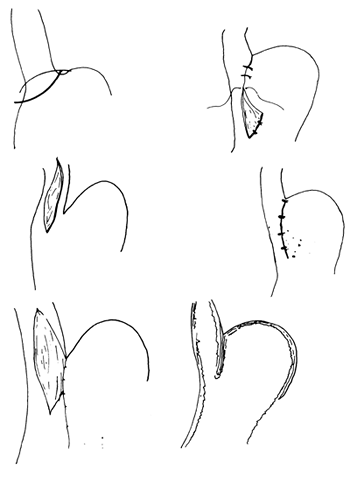 |
Fig. 142-5. Esophagomyotomy performed through the abdomen. The muscle incision should be 6 to 8 cm above the junction and stop at the first subserosal gastric vessels. A loose anterior fundoplication is done with the gastric fundus in both edges of the myotomy. |
Table 142-4. Results of Esophagomyotomy in Four Large Series for Chagas Megaesophagus | |||||||||||||||||||||||||||||||||||
|---|---|---|---|---|---|---|---|---|---|---|---|---|---|---|---|---|---|---|---|---|---|---|---|---|---|---|---|---|---|---|---|---|---|---|---|
|
Manometric studies were performed to evaluate the procedure, and the vigorous achalasia disappeared in more than one-half of cases. One may assume that this finding is related to the improvement in smooth muscle function on account of the relief of the obstruction and the absence of food stasis in the esophageal lumen. Radiologic studies performed 3 years after the cardioplasty revealed a reduction in the esophageal transit time to less than 30 minutes (Fig. 142-7).
The measurement of the esophageal emptying time with a 99mTc diethylenetriamine pentaacetic acid meal has also revealed a diminishing curve as compared with normal and after the cardioplasty. Studies done 4 years later with a similar technique looking for reflux have been negative. As I (1991, 1996) and my colleagues (1988) have noted in cases of acute perforation and after other methods have been unsuccessful, cardioplasty has been satisfactory.
For patients with the advanced stage of achalasia, interest has been renewed in removing the dilatated organ and replacing it with a gastric tube. The reason for this approach is based on the possible higher incidence of cancer when other methods have not worked as a primary treatment. In most reported series, the coexistence of carcinoma and achalasia is low. Rezende (1985) found an incidence of 0.8% in 600 endoscopic examinations, Pinotti and associates (1980) found 2.9%, and I and my associates (1987) found 2.8%.
The removal of the esophagus for megaesophagus was first proposed by Camara-Lopes (1955) in Brazil. The approach was transpleural, and the anastomosis was in the chest. The complication rate was high. The transhiatal technique has been championed by Ferreira (1991), Orringer and Stirling (1989), and Miller (1995) and Pinotti (1997) and their associates. Experienced esophageal surgeons have not entirely agreed with the idea of removing the esophagus. Functionally, a dilatated, aperistaltic, and depopulated-neuron organ is removed, it is replaced by another one that has the same characteristics (i.e., denervated), and the vagi are cut. Moreover, the technique is not simple and cannot be considered as benign as a myotomy or a cardioplasty.
In a collected review of 301 cases of esophagectomy for achalasia, both idiopathic and chagasic, I (1991) found a mortality rate of 3.97% and complications in 24%. For a benign disease, the morbidity and mortality are too high compared with those associated with simpler procedures. Miller and colleagues (1995) reported results with 37 patients in
P.2169
P.2170
whom the esophagus was removed either through the chest or transhiatally in cases of recurrent achalasia. This series had two deaths (5.4%) and a complication rate of 32.4%, including cardiac dysrhythmia, cervical anastomotic leak, transient vocal cord paralysis, pneumonia, and pulmonary embolus; two patients were reexplored for bleeding. Devaney and colleagues (2001) from the University of Michigan updated their experience with esophagectomy for achalasia in a group of 93 patients. The hospital length of stay was 12.5 days, and anastomotic leak occurred in 10%, recurrent laryngeal nerve injury in 5%, delayed mediastinal bleeding requiring thoracotomy in 2%, chylothorax in 2%, and hospital deaths in 2%. Operating in the same subset of patients (i.e., reoperation), I (1996) had no morbidity or mortality, and more than 90% of the patients had a good result. I used a much simpler approach: cardioplasty with an endoluminal valve. The techniques of excising the esophagogastric junction and replacing it with various segments of bowel, either large or small, have been used with a degree of success but with high morbidity and mortality rates. The largest experience is that of da Silva and associates (1987) with 170 patients with a jejunal interposition. In this group, there were 10 deaths (5.9%) and 54 complications (31.8%).
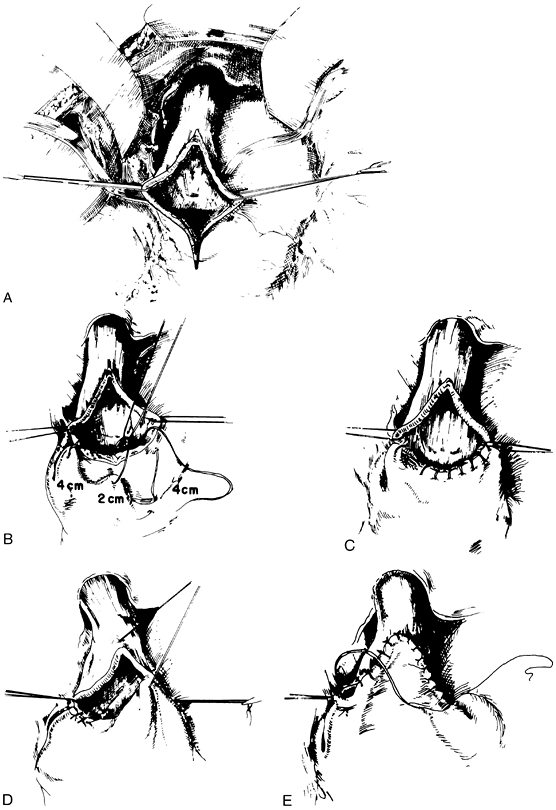 |
Fig. 142-6. Technique used for cardioplasty with an endoluminal valve through the abdomen. A. Opening of the gastroesophageal junction is 6 to 8 cm above and 2 cm below. B, C. Endoluminal antireflux valve with the anterior gastric wall, which is sutured to the lower opening of the gastroesophageal junction. D, E. Remaining opening of the gastroesophageal opening is closed with the anterior surface of the stomach using interrupted stitches. Courtesy of H. Barreto. |
Table 142-5. Results of Thal Cardioplasty in Advanced Chagas' Megaesophagus (Brazilian Literature) | ||||||||||||||||||||||||||||||||||||||||||||||||||
|---|---|---|---|---|---|---|---|---|---|---|---|---|---|---|---|---|---|---|---|---|---|---|---|---|---|---|---|---|---|---|---|---|---|---|---|---|---|---|---|---|---|---|---|---|---|---|---|---|---|---|
|
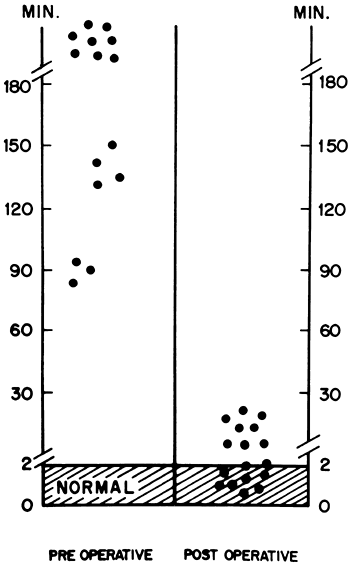 |
Fig. 142-7. Esophageal emptying time after cardioplasty, measured with a barium meal. Time is reduced to less than 30 minutes in the postoperative period. |
Aquino (1996) used the endoesophageal pull-through technique described by Saidi (1988) in treating cancer of the esophagus to remove the organ in advanced cases of megaesophagus. In 22 patients thus treated, there was one death (4%), with good results in 17 (77%) but a high rate of fistula in the neck (22.7%).
Laparoscopic video-assisted surgery has been used extensively since the original report of 17 patients with nonadvanced achalasia by Pellegrini and colleagues (1992). In their experience, there were no deaths, and the average hospital stay was 3 days. The results were good to excellent in 82%, and 3 patients (17%) required reoperation. Paula and associates (1992) performed 38 thoracoscopic Heller myotomy and fundoplication procedures with one death (2.6%) and three perforations (7.9%). Graham and associates (1997) reported 26 laparoscopic video-assisted procedures. Postoperative complications included subcutaneous
P.2171
emphysema in four patients, atelectasis in three patients, small pneumothorax in two patients, delayed gastric emptying in one patient, and esophageal perforation in one patient. The median hospital stay was 5 days, and mean operative time was 3.5 hours. All patients noted improvement in their dysphagia score. Recent series reported by Patti (1999) and Sharp (2002) and their co-workers using this technique with 100 patients or more followed beyond 5 years have shown that the laparoscopic approach is equally as effective as the open method.
By the open method, I (2001) operated on more than 300 patients, with a mortality rate of 0.6%. The patient is discharged within 24 hours, liquid diet is offered soon after the patient is awake, and the operative time is less than 90 minutes. Robotic-assisted Heller myotomy has also been used by Melvin (2001) in a few cases of early-stage achalasia, demonstrating the benefits of extra magnification and three-dimensional imaging that may help prevent perforation and identify residual muscle fibers.
REFERENCES
Allgrove J, et al: Familial glucocorticoid deficiency with achalasia of the cardia and deficient tear production. Lancet 1:1284, 1978.
Andrade ZA, Andrade SG: Trypanosoma cruzie doen a de Chagas. Rio de Janeiro: Guanabara-Koogan, 1989, p. 199.
Andreollo NA, Earlam RJ: Heller's myotomy for achalasia: is an added anti-reflux procedure necessary? Br J Surg 74:765, 1987.
Annese V, et al: Controlled trial of botulinum toxin injection versus placebo and pneumatic dilation in achalasia. Gastroenterology 111: 1418, 1996.
Anselmino M, et al: Heller myotomy is superior to dilatation for the treatment of early achalasia. Arch Surg 132:233, 1997.
Aquino JLB: Tratamento do megaes fago pela mucosectomia com conserva o da t nica muscular esof gica por via cervicoabdominal. PhD thesis, Campimas, Brazil, 1996.
Barbosa H, et al: Tratamento cir rgico do megaesofago Chag sico. Rev Goiana Med 35:1, 1989.
Brandalise NA, et al: Tratamento cir rgico do megaesofago. Estudo comparativo de duas t cnicas de cardioplastia. Rev Col Bras Cir 6:117, 1979.
Camara-Lopes LH: Transposi o retroesternal do estomago para anastomose cervical. Nota pr via. Ribeir o Preto, SP, set. 1955.
Chagas C: Nova tripanosomiase humana. Estudos sobre a morfologia e o ciclo evolutivo do schizotrypanum cruzi. N. Gen. S. Sp. agente etiol gico de nova entidade m rbida no homem. Mem Inst Oswald Cruz 1:159, 1909.
Correa Neto A: Patogenia, diagnostico e tratamento do megaes fago (mal do engasgo). S o Paulo Nacional, 1935.
Csendes A, et al: Late subjective and objective evaluation of the results of esophagomyotomy in 100 patients with achalasia of the esophagus. Surgery 104:469, 1988.
Csendes A, et al: Late results of a prospective randomised study comparing forceful dilatation and oesophagomyotomy in patients with achalasia. Gut 30:299, 1989.
Dantas RO, et al: Lower esophageal sphincter pressure in Chagas' disease. Dig Dis Sci 35:508, 1990.
da Silva AL, da Con eic o SA, Alvarenga Sliva M de L: Interposic o de alca jejunal no tratamento cir rgico do megaes fago ch gasico: an lise do p soperat rio imediato. Rev Assoc Med Bras 33:94, 1987.
Devaney EJ, et al: Esophagectomy for achalasia: patient selection and clinical experience. Ann Thorac Surg 72:854, 2001.
Etzel E: Neuropatologia do megaes fago e megacolon. Estudo de 5 casos. An Fac Med S o Paulo 10:383, 1934.
Felix VN, et al: Achalasia: a prospective study comparing the results of dilatation and myotomy. Hepatogastroenterology 45:97, 1998.
Ferguson MK: Achalasia: current evaluation and therapy. Ann Thorac Surg 53:1336, 1991.
Ferraz E, et al: Late results on the surgical treatment of chagasic megaesophagus with Thal-Hatafuku procedure. J Am Coll Surg 193:493, 2001.
Ferreira EAB: Tratamento cir rgico do megaes fago pela esofagectomia sem toracotomia e esofagogastroplastia cervical. In Leonardi LS: Controversias na cirurgia do aparelho digestivo. Sa Paulo: Medsi, 1991, p. 30.
Gordon JM, Eaker EY: Prospective study of esophageal botulinum toxin injection in high-risk achalasia patients. Am J Gastroenterol 92:1812, 1997.
Graham AJ, et al: Laparoscopic esophageal myotomy and anterior partial fundoplication for the treatment of achalasia. Ann Thorac Surg 64:785, 1997.
Guarino JL: As opera es de Thal no tratamento do megaes fago. Thesis, FMUFF, 1975.
Hatafuku H, Maki T, Thal AP: Fundic patch operation in the treatment of advanced achalasia of the esophagus. Surg Gynecol Obstet 134:617, 1972.
Heller E: Extramukose cardioplastik beim chronischen cardiospasmus mit dilation des oesophagus. Mitt Grenzgeb Med Chir 27:141, 1913.
Hurst AF, Rake GW: Achalasia of the cardia (so called cardiospasm). Q J Med 23:491, 1930.
Koberle F, Alcantara FG: Esofagoneuropatias perif ricas. Rev Goiana Med 35:81, 1989.
Koberle F, Nabor E: Etiologia e patogenia do megaes fago no Brasil. Rev Paul Med 47:643, 1955.
Malafaia O: Tratamento cir rgico do megaes fago pela cardioplastia a Thal. In Leonardi SL: Controversias na cirurgia do aparelho digestivo. Sa Paulo: Medsi, 1991, p. 38.
Melvin WS: Computer-assisted robotic Heller myotomy: initial report. J Laparoendosc Adv Surg Surg Tech 11:251, 2001.
Miller DL, et al: Esophageal resection for recurrent achalasia. Ann Thorac Surg 60:922, 1995.
Nakadaira A, et al: Tratamento do megaes fago pela t cnica de Thal. Rev Assoc Med Bras 20:371, 1977.
Orrel RW, Clark AJL: ALADIN, but where's the genie? Neurology 58:847, 2002.
Orringer MB, Stirling MC: Esophageal resection for achalasia: indications and results. Ann Thorac Surg 47:340, 1989.
Pasricha PJ, et al: Botulinum toxin for achalasia: long-term outcome and predictors of response. Gastroenterology 110:1410, 1996.
Patti MG, et al: Minimally invasive surgery for achalasia: an 8 year experience with 168 patients. Ann Surg 130:587, 1999.
Paula AL, et al: Heller modificado laparosc pico para o tratamento do megaes fago chag sico. In Proceedings XXXII Braz Cong Gastroenterol Natal Rn, Brazil, 1992, p. 5.
Pellegrini C, et al: Thoracoscopic esophagomyotomy: initial experience with a new approach for treatment of achalasia. Ann Surg 216:291, 1992.
Pinotti HW, Cecconello I, De Oliveira MA: Transhiatal esophagectomy for esophageal cancer. Semin Surg Oncol 13:253, 1997.
Pinotti HW, Pollara WM, Raia AA: Tratamento cir rgico do megaes fago avan ado pela esofagectomia subtotal por via c rvico-abdominal sem toracotomia com abertura do diafragma. Rev Assoc Med Bras 26:339, 1980.
Ramos O: Eletrocardiographie ches malades atteintes de megaesophagus et megacolon. Folia Clin Biol 7:149, 1935.
Rassi L: Criterio seletivo no tratamento cirurgico do megaes fago chag sico. Rev Goiana Med 25:85, 1979.
Reynolds JC, Parkman HP: Achalasia. Gastroenterol Clin North Am 18: 223, 1989.
Rezende JM Jr: Estudo cintilogr fico do transito esofagiano na esofagopatia chag sica. Thesis, 1985.
Rezende JM: Manifesta s digestivas da doen a de Chagas. In Dani LP: Gastroenterologia clinica. Rio de Janeiro: Guanabara-Koogan, 1988, p. 1387.
Rezende JM, et al: Endoscopia no megaes fago. Estudo prospectivo de 600 casos. Arq Gastroenterol 22:53, 1985.
Sader AA, et al: Gastroesofagoplastia modificada para o tratamento do megaes fago. Rev Assoc Med Bras 21:72, 1975.
Saidi F: Endoesophageal pull through. A technique for the treatment of cancers of the cardia and lower esophagus. Ann Surg 207:446, 1988.
P.2172
Schiano TD, et al: Use of botulinum toxin in the treatment of achalasia. Dig Dis Sci 16:14, 1998.
Sharp KW, et al: 100 consecutive minimally invasive Heller myotomies: lessons learned. Ann Surg 235:631, 2002.
Spechler JS: AGA technical review on treatment of patients with dysphagia caused by benign disorders of the distal esophagus. Gastroenterology 117:1, 1999.
Thal AP, Hatafuku T: A new method for reconstruction of the esophagogastric junction. Surg Gynecol Obstet 120:1225, 1965.
Wendel W: Zur chirurgie des esophagus. Arch Klin Chir 93:111, 1910.
World Health Organization: Control of Chagas' Disease. Technical report series. Geneva: World Health Organization, 1991.
Ximenes M III: Chagas' megaesophagus. Current review of techniques and results. Rev Saude DF 2:207, 1991.
Ximenes M III: Esophageal resection for recurrent achalasia. Ann Thorac Surg 62:322, 1996.
Ximenes M III: Surgical options in the treatment of Chagas' achalasia. Rev Saude DF 12:5, 2001.
Ximenes M III, Gaiotto FTC: Disturbios da motilidade esofagiana. Clin Bras Cir 3:221, 1997.
Ximenes M III, Silva RO, Fleury I: Thal's procedure in the management of Chagas' megaesophagus. GEN 36:142, 1982.
Ximenes III M, et al: Primary surgical treatment of Chagas' megaesophagus. Results of 450 cases. HFA Pub Tec Cient 2:247, 1987.
Ximenes III M, et al: Refluxo gastroesofagiano no megaes fago chag sico. Rev Col Bras Cir 15:75, 1988.
Zilberstein B, et al: Doen as associadas em megaes fago chag sico. Ann XIX Braz Coll Surg Meet 1991, p. 326.
Zucoloto S, Rezende JM: Mucosal alterations in human chronic chagasic esophagopathy. Digestion 47:138, 1990.
Reading References
Bonavina L, et al: Primary treatment of esophageal achalasia. Long-term results of myotomy and Dor fundoplication. Arch Surg 127:222, 1992.
Ellis FH, Crozier RE, Watkins E Jr: Esophagomyotomy for achalasia. Dis Esophagus 1:81, 1988.
Jara FM, et al: Long-term results of esophagomyotomy for achalasia of the esophagus. Arch Surg 114:935, 1979.
Ximenes M III: Ruptured Chagas' megaesophagus. Surg Gynecol Obstet 168:263, 1989.
Ximenes M III, Andrade FOS, Miranda PEB: Reopera o no megaes fago chag sico. Rev Bras Cir 66:323, 1976.
Ximenes III M, Silva RO, Vieira LF: Surgical treatment for Chagas achalasia made simple and safe. In XII Proceedings of the Annual Meeting of the European Association for Cardiothoracic Surgery, Lisbon, Portugal, 2001, p. 510.
EAN: 2147483647
Pages: 203